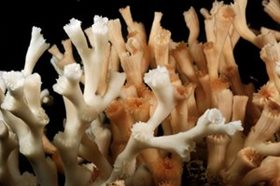Fusion in cold-water corals: building the framework for success
28 October 2014
 Cold-water corals growing in the seas around Scotland and northern Europe have developed an ingenious way of overcoming their environmental challenges to grow into large-scale reefs, according to scientists at Heriot-Watt University.
Cold-water corals growing in the seas around Scotland and northern Europe have developed an ingenious way of overcoming their environmental challenges to grow into large-scale reefs, according to scientists at Heriot-Watt University.
Building large reefs is a challenge for cold-water corals. In tropical reefs, encrusting coralline algae bind together dead coral skeletons to make continuous reef structures, but for cold-water corals this is not possible, as they mostly live in water deeper than light can penetrate, where algae cannot grow. Instead, Heriot-Watt researchers have discovered, different coral individuals 'fuse' together to create larger, more stable frameworks.
This discovery of this ‘fusion’, and that these cold-water corals have the potential to recognise 'self' at a species level has led to a greater understanding of how cold-water corals can engineer massive three-dimensional habitats, which are key to their success as well as the success of the thousands of species the reefs support.
 The discovery was made whilst Heriot-Watt marine biologists Dr Sebastian Hennige and Professor Murray Roberts were diving in the JAGO submersible on cold-water coral reefs, allowing them to see and explore these hidden reefs first-hand. Said Dr Hennige, "Normally it is very hard to see where one coral ends and another begins, but in the submersible we were able to find reefs where orange and white types of the coral fused together. Coming from a tropical coral research background, seeing coral fusing like this instantly grabbed my attention so we were able to successfully sample some corals for genetic and skeletal tests to prove that fusion happens between different individuals.”
The discovery was made whilst Heriot-Watt marine biologists Dr Sebastian Hennige and Professor Murray Roberts were diving in the JAGO submersible on cold-water coral reefs, allowing them to see and explore these hidden reefs first-hand. Said Dr Hennige, "Normally it is very hard to see where one coral ends and another begins, but in the submersible we were able to find reefs where orange and white types of the coral fused together. Coming from a tropical coral research background, seeing coral fusing like this instantly grabbed my attention so we were able to successfully sample some corals for genetic and skeletal tests to prove that fusion happens between different individuals.”
Many people, added Dr Hennige, think of cold water reefs being small, but they can be massive, and their ability to fuse together is key to this. It had previously been assumed that these massive reefs were made by siblings joining together, but, they are in fact fusing between genetically distinct individuals, as though two people sitting closely together were able to fuse their skeletons. This skeletal fusion and the potential ability of cold-water corals to recognise ‘self’ at a species level is quite different from what is seen in tropical corals, which often fight each other when they come into contact. The technology that we used to minutely examine the skeleton biomineralisation and to characterise this fusion has great potential for future coral research, said Dr. Nick Kamenos of Glasgow University, co-author of the paper, adding that it’s the combination of techniques, both biological and physical, that have made this discovery possible.
 Professor Murray Roberts, co-ordinator of Heriot-Watt’s new Lyell Centre for Earth and Marine Science and Technology, said, “This discovery highlights not only how much we have to learn about deep-sea ecosystems but how important advanced technologies are in deep-sea exploration. The chance to explore these deep coral reefs from a submersible allowed us to observe the corals fusing and get the all-important samples back to the ship.”
Professor Murray Roberts, co-ordinator of Heriot-Watt’s new Lyell Centre for Earth and Marine Science and Technology, said, “This discovery highlights not only how much we have to learn about deep-sea ecosystems but how important advanced technologies are in deep-sea exploration. The chance to explore these deep coral reefs from a submersible allowed us to observe the corals fusing and get the all-important samples back to the ship.”
This adaptation, say the researchers, offers the species two key problem-solving benefits:
-
In the deep seas, there is no light, so calcifying algae cannot bind together dead corals as happens on tropical reefs. Without being able to fuse together, deep corals would simply not make large, biodiversity supporting structures. This ability may therefore have evolved as a way to stabilise their own habitat.
-
The second reason is energy. It is energetically costly to fight each other, and the deep seas are a low energy environment, so it makes sense that they may have evolved away from being aggressive to their neighbours.